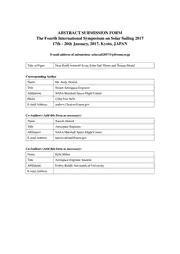
NASA Technical Reports Server (NTRS) 20170001510: Near Earth Asteroid Scout Solar Sail Thrust and Torque Model PDF
Preview NASA Technical Reports Server (NTRS) 20170001510: Near Earth Asteroid Scout Solar Sail Thrust and Torque Model
ABSTRACT SUBMISSION FORM The Fourth International Symposium on Solar Sailing 2017 17th - 20th January, 2017, Kyoto, JAPAN E-mail address of submission: [email protected] Title of Paper Near Earth Asteroid Scout Solar Sail Thrust and Torque Model Corresponding Author Name Mr. Andy Heaton Title Senior Aerospace Engineer Affiliation NASA Marshall Space Flight Center Phone (256) 544-3839 E-mail Address [email protected] Co-Authors (Add this form as necessary) Name Naeem Ahmad Title Aerospace Engineer Affiliation NASA Marshall Space Flight Center E-mail Address [email protected] Co-Authors (Add this form as necessary) Name Kyle Miller Title Aerospace Engineer Student Affiliation Embry Riddle Aeronautical University E-mail Address Abstract The Near Earth Asteroid (NEA) Scout is a solar sail mission whose objective is to scout at least one Near Earth Asteroid to help prepare for human missions to Near Earth Asteroids. NEA Scout will launch as a secondary payload on the first SLS-Orion mission. NEA Scout will perform a small trim maneuver shortly after deploy from the spent SLS upper stage using a cold gas propulsion system, but from that point on will depend entirely on the solar sail for thrust. As such, it is important to accurately characterize the thrust of the sail in order to achieve mission success. Additionally, the solar sail creates a relatively large solar disturbance torque that must be mitigated. For early mission design studies a flat plate model of the solar sail with a fixed center of pressure was adequate, but as mission concepts and the sail design matured, greater fidelity was required. Here we discuss the progress to a three-dimensional sail model that includes the effects of tension and thermal deformation that has been derived from a large structural Finite Element Model (FEM) developed by the Langley Research Center. We have found that the deformed sail membrane affects torque relatively much more than thrust; a flat plate model could potentially model thrust well enough to close mission design studies, but a three-dimensional solar sail is essential to control system design. The three-dimensional solar sail model revealed that thermal deformations of unshielded booms would create unacceptably large solar disturbance torques. The original large FEM model was used in control and mission simulations, but was resulted in simulations with prohibitive run times. This led us to adapt the Generalized Sail Model (GSM) of Rios-Reyes. A design reference sail model has been baselined for NEA Scout and has been used to design the mission and control system for the sailcraft. Additionally, since NEA Scout uses reaction wheels for attitude pointing and control, the solar torque model is essentially to successfully design the NEA Scout momentum management control system. We have also updated the estimate of diffusivity used for the aluminized sail material based on optical testing of wrinkled sail material. The model presented here represents the current state of the art of NASA’s ability to model solar sail thrust and torque. Figure x) NEA Scout Three-Dimensional Sail Model (Z-axis exaggerated) Figure y) NEA Scout 3-Dimensional Thrust Compared to Flat Plate Figure z) NEA Scout 3-Dimenational Disturbance Torque Compared to Flat Plate
